The origin of the 1918–1920 world influenza pandemic is uncertain. One theory is that it first appeared in a US army camp in Kansas.1 When the soldiers were shipped to France to take up their positions on the Western Front, the influenza accompanied them. This virulent new flu infected friend and foe alike.
Wartime censorship amongst the combatant nations meant that it was only reported when it started to appear in neutral Spain, leading to it being unfairly christened Spanish Flu. With troop movements and repatriation at war’s end, the virus spread widely and rapidly.
Illustrated cover Oliver, W. (1919). Spanish influenza : all about it Melbourne: Specialty.
Australia’s isolation gave us time to prepare and the Commonwealth and states gathered together in November 1918 to agree on a plan to protect the country. Their first decision was to name it Pneumonic Influenza. 2
The initial focus was concentrated on quarantining incoming ships. This was successful for a time, but as we have become acutely aware recently, viruses don’t respect quarantine rules.
In January a traveller from Melbourne arrived in Sydney and was declared to have contracted pneumonic influenza. This caused a breakdown between the states with New South Wales claiming Victoria hadn’t reported a known case. The November agreement crumbled as the states went their own way.
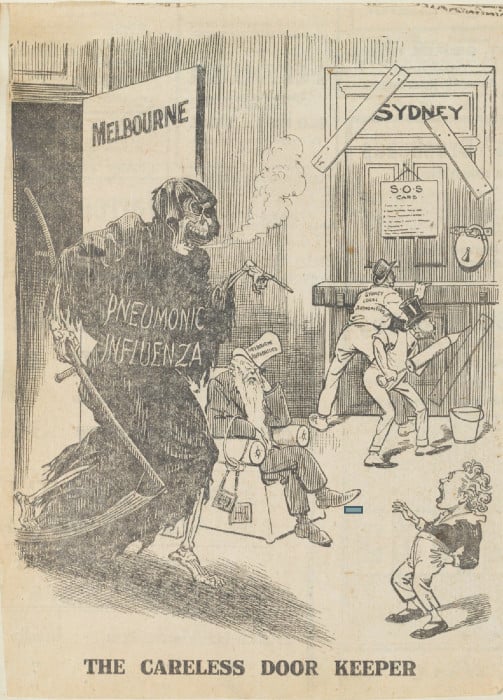
In February returned soldiers aboard the Argyllshire sailed from Melbourne to Sydney. Confusion over quarantine led to some desertions from the ship in Sydney Harbour. A further 1000 men broke from their quarantine camp at North Head, finally agreeing to quarantine for several days at Sydney Cricket Ground. Private W. J. Williamson, one of the first absconders, was court martialled and imprisoned for 60 days.
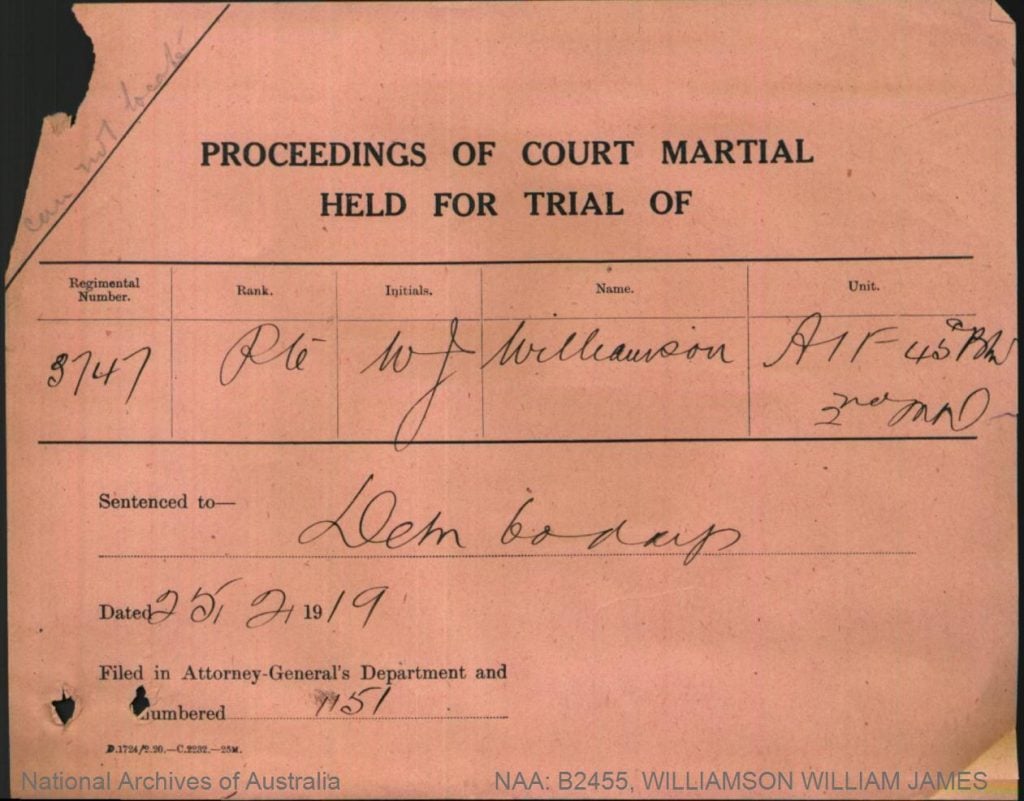
The incident brought to the surface the conflicts amongst the states and Commonwealth.
The [NSW] State authorities may well feel indignant and almost dismayed at what the Minister for Health properly describes as an outrage…. They have been putting up a most intelligent —speaking generally — and successful fight against the menace itself, against Victorian criminal negligence and secrecy, against the crass stupidity and hampering tactics of the Federal Government, and against the wilful disobedience of many of the citizens they are striving to protect. (The Argyllshire mutineers The Grafton Argus and Clarence River General Advertiser 12 February 1919, p 2).
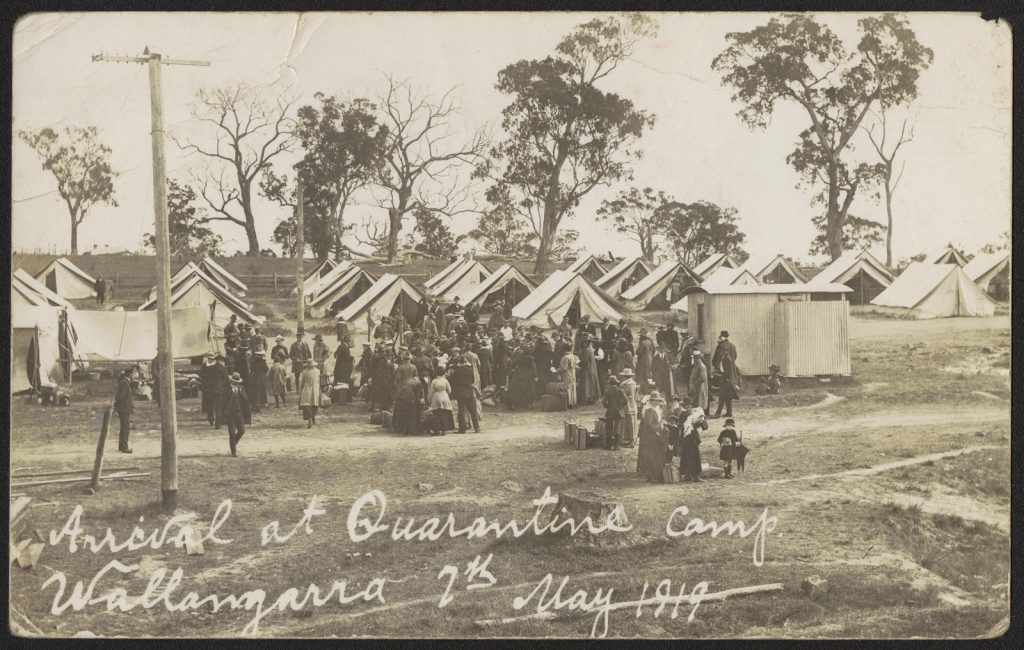
The virus spread quickly. Quarantine camps started to appear at state borders.
In Melbourne the Exhibition Building was hastily commissioned as a hospital for flu victims.
The building already had several tenants. The State Parliament occupied the western hall, having been reluctantly pushed from their own house by the new Commonwealth Parliament.
The Exhibition buildings also housed an Aquarium.

The opening of this new temporary hospital brought a number of issues with it; not least of which was staffing. The Catholic Archbishop Daniel Mannix offered to provide nuns from the nursing orders, supported by Christian Brothers and Jesuits. This was initially accepted by Health Minister, John Bowser. Despite theological differences, the Anglican Church noted that they welcomed the Roman Catholics as ‘independent helpers.’ 3
At an open air Sunday gathering at the Wesley Church, fiery preacher Henry Worrall, was not so ecumenical.
We are now informed [that Archbishop Mannix] who represents the minor section of the community and is himself regarded as anti-British in all his utterances is given the position of supremacy in a great national crisis (Herald, 17 February 1919, p 8).
The best sentiment of the community will be shocked by the action of the Minister for Health, Mr Bowser in handing over, at the suggestion of Archbishop Mannix, the newly established hospital in the Exhibition Building … to the care of a sacerdotally trained band of anti-Protestants (Cairns Post 18 February, p 9).
The Health Minister hastily did an about turn, now rejecting Mannix’s offer. This outraged the Catholic community. Archbishop Mannix responded.
The issue the government has to face, as everybody recognises, is whether or not the government is going to submit to sectarian dictation …. One things is for certain, that I will not allow the Sisters to place themselves under the control of any Department, or Cabinet, or Government which may prove its inability to resist the pressure knot of sectarian bigots.4
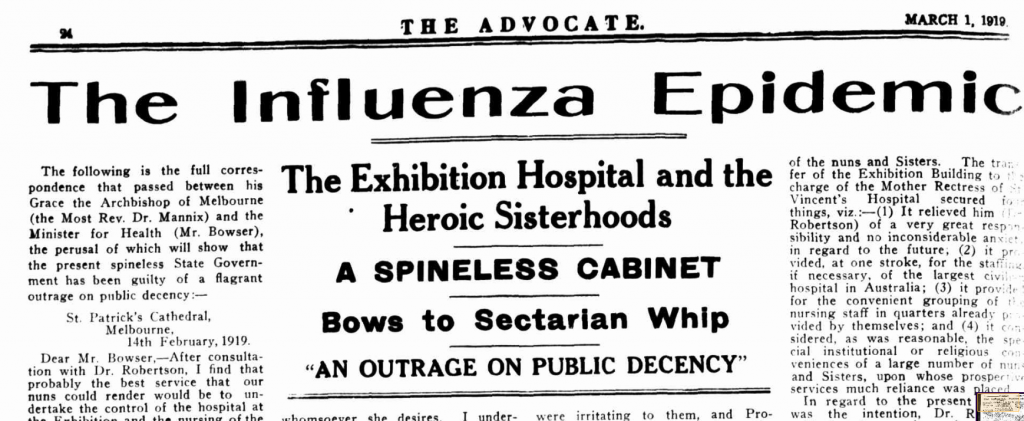
The Exhibition Hospital continued treating flu patients although staffing remained an issue. Richard Toutcher, a member of the Legislative Assembly, expressed the concerns of the Victorian State Parliament at sharing space with a fever hospital.
I think that if an analysis were made it would be found that there have been more deaths of influenza patients in the Exhibition Hospital than in any other institution. It is a menace to everybody, including members of this House who have to sit so close to the hospital (Hansard, 6 Aug 1919, p 503).
Dangers to politicians was no doubt mitigated as parliament did not sit for the first six months of 1919.
A range of regulations were introduced in an attempt to contain the spread of the virus.
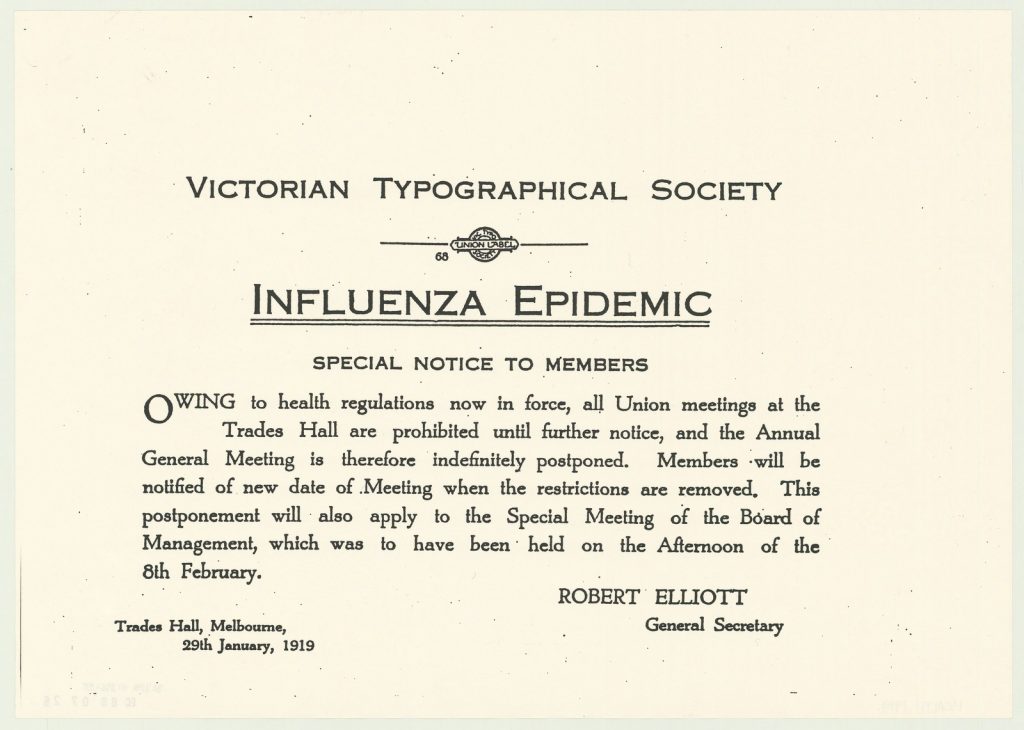
Many of these will seem quite familiar to us. Schools and theatres were closed. There were limits on gatherings, masks were mandatory at church services, crowds at local sport were limited and horse racing meetings were prohibited. Our Library closed in late January, reopening in early March. 5
Many of the restrictions were removed or adjusted over the next few months and remarkably, from the commencement of the season on 3 May 1919, the Victorian Football League played matches in front of large crowds.

The pathology of influenza wasn’t understood at the time. The recently formed Commonwealth Serum Laboratories developed a vaccine but it fought bacterial rather than viral infections. It was, though, effective in warding off secondary infections of flu victims, and did save lives.
Advertisers made many dubious claims about the efficacy of their product in mitigating the dangers of influenza.
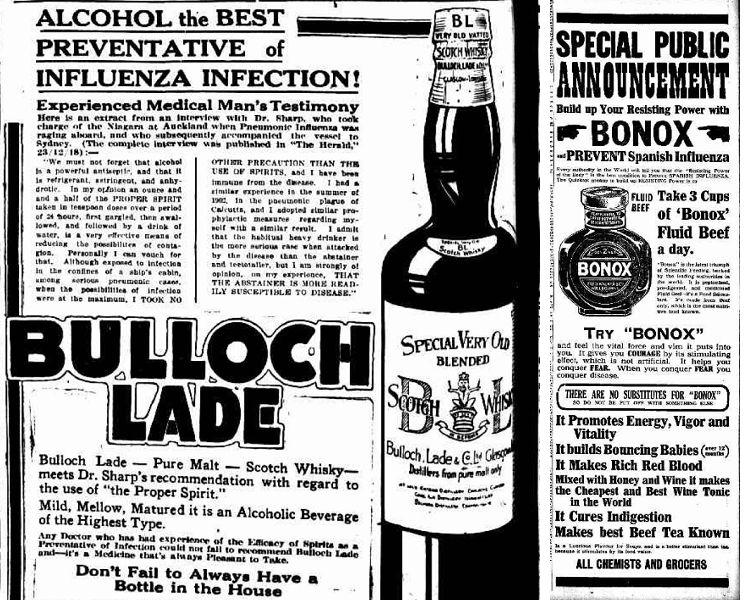
There were several waves of influenza in Australia from February to July. After that the pandemic began to wane, possibly because of the immunity attained by the surviving 40 per cent of the population who had been infected.
The temporary hospitals were progressively closed. The Exhibition Hospital was closed in mid-September when the final patients left.
The pandemic left 12,000 to15,000 deaths across Australia. The world-wide death toll dwarfed the mortality of the First World War. The figures are very imprecise but it is likely over 50 million people succumbed.
The pandemic receded, but the deaths and disruption, following so quickly after the trauma and loss of World War I, cast long shadows over many families and communities.
When Spanish Flu came to Victoria video. See details of the newspaper articles used in the above video.
References
- Erkoreka A, 2009, ‘Origins of the Spanish Influenza pandemic (1918-1920) and its relation to the First World War,’ Journal of molecular and genetic medicine : an international journal of biomedical research, 3(2), pp 190–194
- Department of the Prime Minister and Cabinet, 1919, Spanish Influenza: Conference at Melbourne Precautionary Measures, p 32 (National Archives of Australia: A2, 1919/482 Part 2)
- ‘The Exhibition Building,’ The Church of England Messenger, 21 February 1919, p 701
- Australian Catholic Truth Society, 1919, Archbishop Mannix and the Victorian Government : no popery and the Spanish influenza, Australian Catholic Truth Society, Melbourne pp 16, 18
- Report of the Trustees of the Public Library, Museums, and National Gallery of Victoria, for 1919 Parliamentary paper / Parliament of Victoria no 11 p 10, Library closed The Herald 30 January 1919 p 8, General news The Age 5 March 1919 p 10

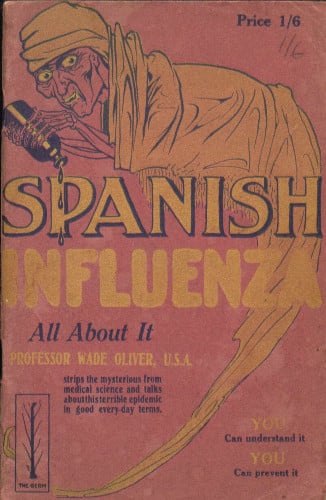

Fabulous presentation. Thanks for your efforts.
Regards,
Karen
This is wonderful! Thank you for your research.
Thanks Michelle, glad you enjoyed it.
I found this very interesting as my grandfather died from the ‘Spanish Flu’ in 1919 (age 34)leaving my grandmother with 7 young children to raise on her own. The local doctor in the small Victorian town of Natimuk where my grandfather died was amazing – acting swiftly to close schools, churches etc and turning the courthouse into a quarantine hospital. Sadly, my grandfather was the only patient to die at the hospital.
Instilled into my sister and I were values such as; importance of family, community, and always helping those in need. Values we believe have their roots in our family’s ‘Spanish Flu’ experience.
It is wonderful research is now bringing to the surface the story of the ‘Spanish Flu’ and how so many ordinary people in Australia were touched by it. So many parallels with the current pandemic. Thank you SLV for your contribution.
Thanks Heather for sharing that very interesting personal story of your family’s experience.